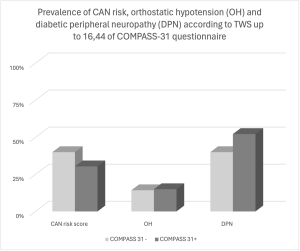Background: COMPASS 31 questionnaire is widely employed for screening of cardiac autonomic neuropathy (CAN) in diabetes, yet its diagnostic performance varies across studies. AIMS. To evaluate the relation between score of the COMPASS 31 and CAN Risk Score in type 2 diabetes (T2D); additionally, to assess its performance in diagnosing diabetic peripheral neuropathy (DPN). Methods: The study involved 53 participants with T2D (mean age 61.74±10.10 years, duration diabetes 9.25±7.33 years, HbA1c 54.64±13.84 mmol/mol, 73.6% males), so far. All participants underwent DPN assessment, orthostatic hypotension (OH) test, and completed the COMPASS 31. DPN was defined by at least one abnormality among neuropathic symptoms (Michigan Neuropathy Screening Instrument-Q, MNSI-Q) and signs (Diabetic Neuropathy Index, DNI and Michigan Diabetic Neuropathy Score, MDNS). COMPASS 31 was analysed to obtain six domain weighted scores and a total weighted score (TWS), which was considered abnormal if >16.44. CAN risk score was calculated. Results: In the total cohort, 43.3% of significant TWS of COMPASS 31 and 35.8% of high CAN risk score have been detected. Moreover, DPN prevalence was 43.5%. The TWS was similar in subjects with low and high CAN risk score (11.45±1.96 vs 12.35±2.83; p 0.650). Considering domains separately, patients at high risk for CAN showed greater impairment in the vasomotor domain (0.48±0.82 vs 1.20±0.27; p 0.032) with strongly correlation between scores (rho=0.29, p=0.037); no differences in the weighted scores of the other domains were found. No correlations between TWS and value of OH and CAN risk score were observed. On the other hand, TWS was correlated more strongly with MNSI-Q (rho=0.302, p=0.029). Conclusion: In these preliminary results, COMPASS 31 exhibits a scarce association with CAN Risk Score in T2D. In contrast, a fair correlation with clinical DPN was observed. Future studies could consider different cut-off of COMPASS 31 in T2D.


